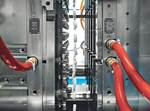‘Industry 4.0’ Demo at Hanover Fair
Linking molding and 3D printing machines and part data via the "cloud" allows "mass customization."
At recent shows such as NPE2015, has demonstrated its interpretation of the international “Industry 4.0” project to create integrated factories via networked production cells and supervisory computers (see March NPE2015 preview). Arburg (whose U.S. office just moved to Rocky Hill, Conn.) has applied Industry 4.0 principles to production of individualized products in series production—also called “mass customization.”
Arburg’s latest and most elaborate demo of this approach was at the April Hanover Fair in Germany. The product was a square rocker-type light switch. At a PC station, visitors chose a personal symbol and name combination, which were added to the individual product order (photo). These data were stored on an RFID chip card, which was inserted into the controller on an Arburg injection machine. The part was molded and an individual data-matrix (DM or QR) code was applied by laser.
The part data was linked to the production machines by means of a cloud. Thus, the DM/QR code applied to the part turned it into an information carrier, controlling its progress through the process chain automatically. (This indelible code is used in automotive safety-related parts such as airbags and in medical parts such as prostheses that are tailored to an individual patient.)
Next, an Arburg Freeformer 3D printer personalized the light switch by applying droplets of plastic onto the surface to produce the preselected symbol and name combination. Then came camera inspection for QC and individual packaging of the part. With the QR code printed on the package, visitors could use a smartphone to retrieve all the process data for their part on an individual web page.
Related Content
-
Three Key Decisions for an Optimal Ejection System
When determining the best ejection option for a tool, molders must consider the ejector’s surface area, location and style.
-
Hot Runners: How to Maintain Heaters, Thermocouples, and Controls
I conclude this three-part examination of real-world problems and solutions involving hot runners by focusing on heaters, thermocouples, and controls. Part 3 of 3.
-
Optimizing Pack & Hold Times for Hot-Runner & Valve-Gated Molds
Using scientific procedures will help you put an end to all that time-consuming trial and error. Part 1 of 2.



